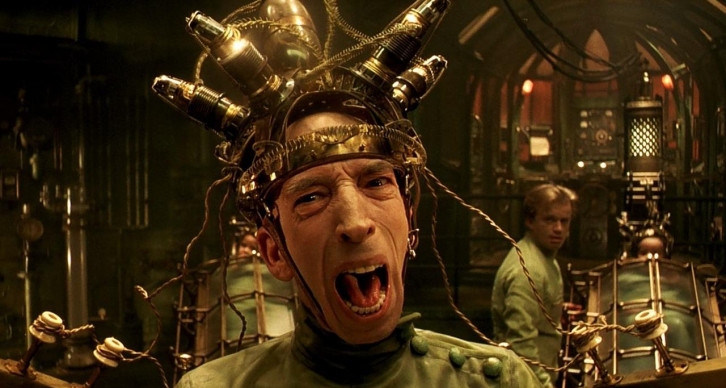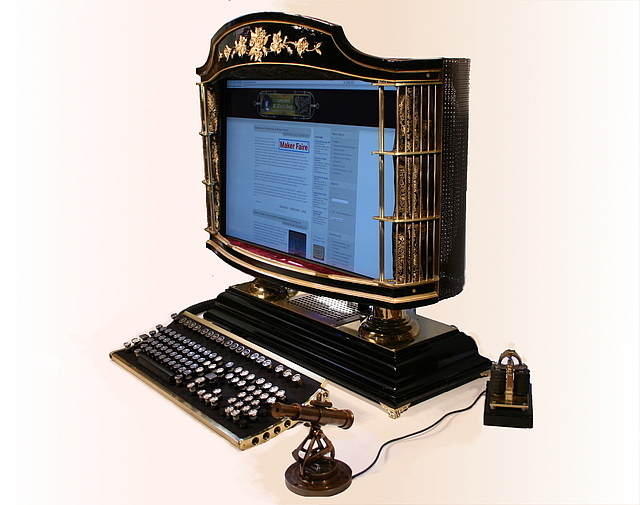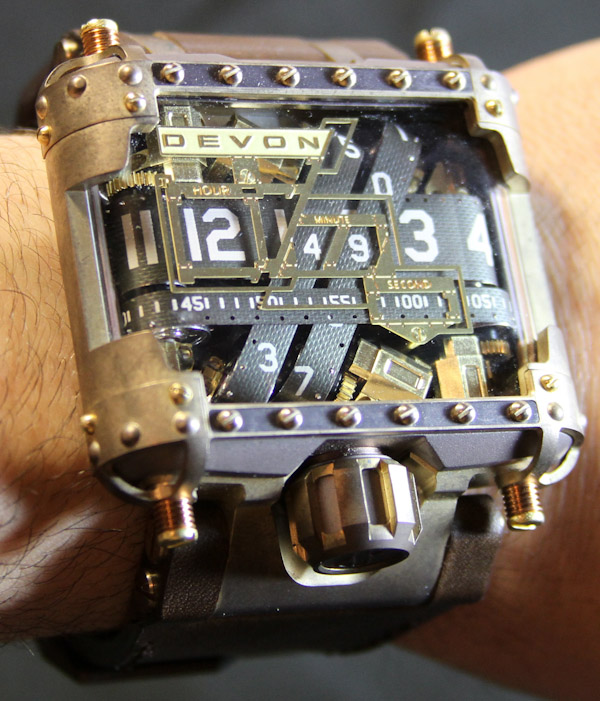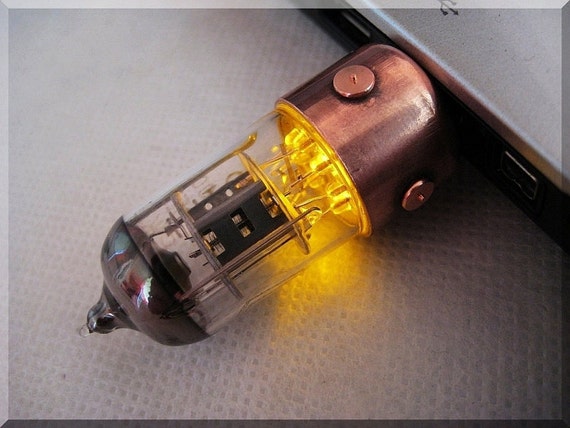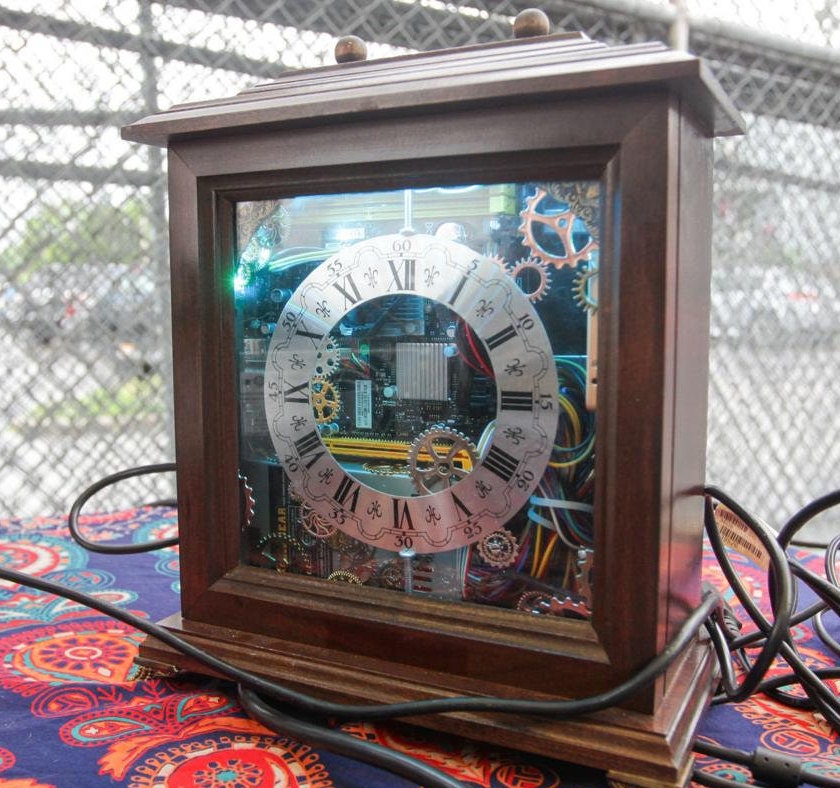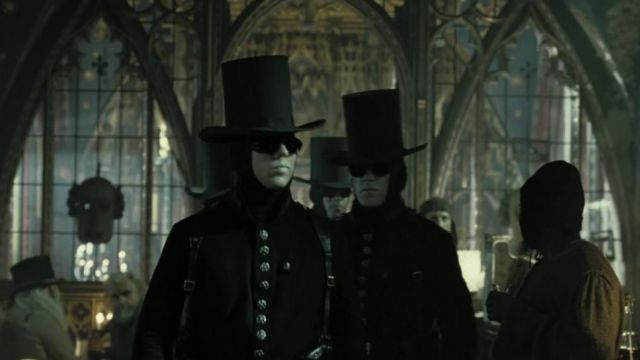What is Steampunk?
Keywords: steampunk, cyberpunk, anachronistic technology, retro-futuristic invention, counterfactual history, neo-noir, clacking, sonic screwdriver.
Steampunk is a sub-genre of science fiction or science fantasy, but it can also be thought of as a sub-culture of society, characterised by costumes and music. It is sometimes said to be a spin-off of the cyberpunk genre - typified in neo-noir films such as Blade Runner, Robocop, 12 Monkeys, Brazil, The Fifth Element and – my favourite – Dark City. But, unlike cyberpunk, which deals with futuristic, dystopian science fiction, steampunk is inspired by 19th century steam-powered technology.
 Read on, for my
essay on Steampunk
Read on, for my
essay on Steampunk- See some photos at Flickr
- Read some notes about the photos, and my costume, here
- If youre local, ... Visit Leeds and Bradford Steampunk Markets
Literature
 A novel that is considered by some to
be the 'type-marker' for steampunk is
The Difference
Engine (1990) by William Gibson and Bruce Sterling. This takes as its
premise that Charles
Babbage succeeded in his ambition to build an advanced mechanical computer
(his Analytical Engine), based on his earlier
Difference
Engine. The novel explores an alternative future where an information
technology revolution takes place in the mid-1800s long before the emergence of
the technology of electronics. Vast warehouse-sized computers filled with
spinning wheels and gears are used for many purposes – including
designing super-efficient steam-powered vehicles, and providing a social
database used by the police and government agencies. John Keats – a
romantic poet in our world – has had his creative talent re-directed
towards computer programming, which is known as clacking in the world of the
Difference Engine. (The term 'clacking' was also used, later, by Terry
Pratchett in his Discworld novel, Going Postal; which features an
Internet-style digital packet-based comms network based on semaphore towers and
clockwork).
A novel that is considered by some to
be the 'type-marker' for steampunk is
The Difference
Engine (1990) by William Gibson and Bruce Sterling. This takes as its
premise that Charles
Babbage succeeded in his ambition to build an advanced mechanical computer
(his Analytical Engine), based on his earlier
Difference
Engine. The novel explores an alternative future where an information
technology revolution takes place in the mid-1800s long before the emergence of
the technology of electronics. Vast warehouse-sized computers filled with
spinning wheels and gears are used for many purposes – including
designing super-efficient steam-powered vehicles, and providing a social
database used by the police and government agencies. John Keats – a
romantic poet in our world – has had his creative talent re-directed
towards computer programming, which is known as clacking in the world of the
Difference Engine. (The term 'clacking' was also used, later, by Terry
Pratchett in his Discworld novel, Going Postal; which features an
Internet-style digital packet-based comms network based on semaphore towers and
clockwork).
"Behind the glass loomed a vast hall of towering Engines – so many that at first Mallory thought the walls must surely be lined with mirrors, like a fancy ballroom. It was like some carnival deception, meant to trick the eye – the giant identical Engines, clock-like constructions of intricately interlocking brass, big as rail cars set on end, each on its foot-thick padded blocks. The whitewashed ceiling, thirty foot overhead, was alive with spinning pulley-belts, the lesser gears drawing power from tremendous spoked flywheels on socketed iron columns. White-coated clackers, dwarfed by their machines, paced the spotless aisles. Their hair was swaddled in wrinkled white berets, their mouths and noses hidden behind white gauze." ...from The Difference Engine

Steampunk now encompasses a timescale ranging from the Industrial Revolution to Edwardian times. The terms anachronistic technology and retro-futuristic invention are used to describe its perspective of the future, as people in the 19th century might have envisioned it.
Modding
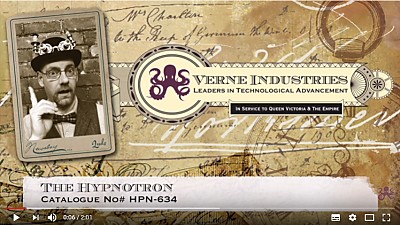
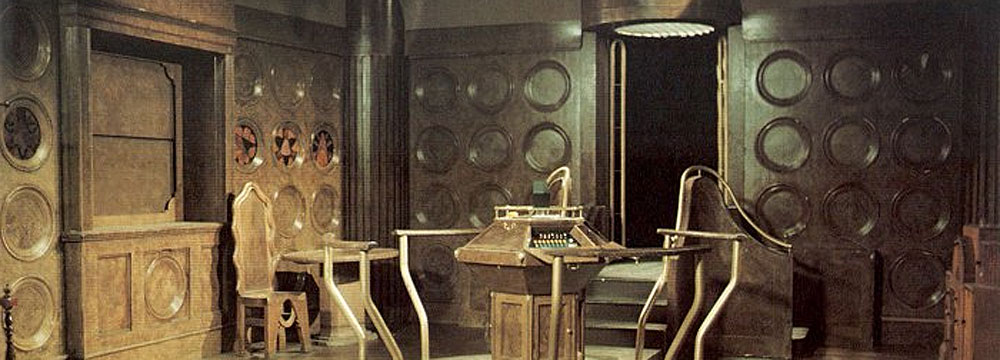 The steampunk sub-culture encompasses artistic styles and
clothing fashions. Protagonists enjoy dressing up and, for a large part, making
their own costumes and 'modding' objects to represent fictional tools and
machines. Present-day objects may be modded to represent a 19th century
version; thus a working laptop computer may be placed into a mahogany case, and
given a brass keyboard. In similar fashion, Doctor Who once had to make use of
an older (Victorian age)
Secondary
TARDIS Console Room, featuring oak panelling. Modding can also create
gadgets – an LED glued to the base of a thermionic valve (vacuum tube)
creates a strange glowing artifact (See Verne Industries; also see the Hypnotron). The 'time
belt' watch, shown below, is a commercial product costing upwards of
US$ 10,000; and there is a lot of steampunk 'art' for sale – some
quite pricey. Datamancer's Telegraph
Mouse is available for US$ 1000.
The steampunk sub-culture encompasses artistic styles and
clothing fashions. Protagonists enjoy dressing up and, for a large part, making
their own costumes and 'modding' objects to represent fictional tools and
machines. Present-day objects may be modded to represent a 19th century
version; thus a working laptop computer may be placed into a mahogany case, and
given a brass keyboard. In similar fashion, Doctor Who once had to make use of
an older (Victorian age)
Secondary
TARDIS Console Room, featuring oak panelling. Modding can also create
gadgets – an LED glued to the base of a thermionic valve (vacuum tube)
creates a strange glowing artifact (See Verne Industries; also see the Hypnotron). The 'time
belt' watch, shown below, is a commercial product costing upwards of
US$ 10,000; and there is a lot of steampunk 'art' for sale – some
quite pricey. Datamancer's Telegraph
Mouse is available for US$ 1000.
Costume
 The
steampunk sub-culture encourages costumes, which can start with a simple
starter kit of top-hat adorned with a pheasant feather and welder's goggles;
progressing to quite complex outfits. Whereas sci-fi fans attending a
convention may decide to dress as Darth Vader, Captain Kirk, or Chmeee,
steampunk artisans tend to favour a generic approach, with an emphasis on
individual creativity. Commentators (e.g. the
Steampunk
Bible) have identified a number of styles, which can include the Aesthete,
the Explorer, the Tinker and (as I term it) the
Prole. The Aesthete
is the dandy in a Victorian or Edwardian suit, with a top hat, cane, pince-nez
or monocle, and waxed moustache. Spats are essential. Ladies might wear
high-button boots, bodices, corsets, lacy gloves. The Explorer might
wear flying gear (including goggles of course) and is equipped for travelling
to unknown regions. He may have a pith helmet and present an 'empire'
appearance; he may even be wearing a utilitarian leather bodice or corset. The
Tinker will, more likely than not, be wearing welder's goggles, perhaps
with a leather apron or lab coat, and other functional items featuring plenty
of pockets. The Prole may be a ragged Victorian street urchin, adopting
punk-like styles from the present era; or may be an Edwardian working person in
a flat cap, woollen jumper and an old stained waistcoat. Kilts are also popular
amongst aesthetes and explorers.
The
steampunk sub-culture encourages costumes, which can start with a simple
starter kit of top-hat adorned with a pheasant feather and welder's goggles;
progressing to quite complex outfits. Whereas sci-fi fans attending a
convention may decide to dress as Darth Vader, Captain Kirk, or Chmeee,
steampunk artisans tend to favour a generic approach, with an emphasis on
individual creativity. Commentators (e.g. the
Steampunk
Bible) have identified a number of styles, which can include the Aesthete,
the Explorer, the Tinker and (as I term it) the
Prole. The Aesthete
is the dandy in a Victorian or Edwardian suit, with a top hat, cane, pince-nez
or monocle, and waxed moustache. Spats are essential. Ladies might wear
high-button boots, bodices, corsets, lacy gloves. The Explorer might
wear flying gear (including goggles of course) and is equipped for travelling
to unknown regions. He may have a pith helmet and present an 'empire'
appearance; he may even be wearing a utilitarian leather bodice or corset. The
Tinker will, more likely than not, be wearing welder's goggles, perhaps
with a leather apron or lab coat, and other functional items featuring plenty
of pockets. The Prole may be a ragged Victorian street urchin, adopting
punk-like styles from the present era; or may be an Edwardian working person in
a flat cap, woollen jumper and an old stained waistcoat. Kilts are also popular
amongst aesthetes and explorers.
Whatever
style of dress you adopt, you will be carrying your futuristic gadgets, ray
gun, soul detector; or perhaps you have borrowed Doctor Who's
sonic
screwdriver? Steampunk also appropriates items from fiction, so an explorer
may be wearing a flying belt (Ringworld) or carrying a stepper box (The Long
Earth) or have a spinner strapped to his back (Discworld: The Thief of Time) or
be carrying a symbol reader inside an old tobacco tin (His Dark Materials:
Northern LIghts). Mechanical watches, and jewellery adorned with cogs are also
de rigeur.
Alternative Histories
Science historians sometimes use a type of thought-experiment called a counterfactual – what if Babbage had completed his analytical engine? – and upon this, different futures can be examined. What if coal had not been readily available in England? There is some speculation amongst historians that the Industrial Revolution could only have taken place in England because …I have not finished this part yet - see sources.
The Allure of Steam
Why are people attracted by steam power and steam engines? I think the allure is that you can see how they work – we can have an understanding in a way that we cannot have with, say, a mobile phone. (Arthur C. Clarke once wrote that any sufficiently advanced technology is indistinguishable from magic). This same ability to understand – or to believe that we understand – the workings applies to vinyl records, photographic film, mechanical calculators, vacuum tubes and the basic internal combustion engine (the type with a distributor and points, rather than an Engine Management System). ok… so what am I going to say next?
…not finished Notes to self: Franklyn. Tractionpunk.
David Gibson, 04-Aug-2018
Minima mutatio:
26/27-Dec-2018
Version 2 – 28-Dec-2018 (still not
finished)
Minima mutatio: 01-Jan-2019, 27-Nov-2020, 17-Aug-2021
This page, http://site2.caves.org.uk/steampunk/index.html was last modified on Tue, 17 Aug 2021 09:00:53 +0000
(Running on britiac3 at 31.25.186.126)
